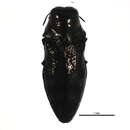Conservation Status
provided by University of Alberta Museums
Common.
- license
- cc-by-nc
- copyright
- University of Alberta Museums
Cyclicity
provided by University of Alberta Museums
July.
- license
- cc-by-nc
- copyright
- University of Alberta Museums
Distribution
provided by University of Alberta Museums
This species is found from Alberta through to Quebec in Canada and south through the United States (Bright, 1987).
- license
- cc-by-nc
- copyright
- University of Alberta Museums
General Description
provided by University of Alberta Museums
These beetles are similar to those of schaefferi in colour and body form. They differ by having pubescent elytral spots and a slightly broader body. From Downie and Arnett: Length 3.5-5.0 mm. Elongate-oblong, markedly tapering on apical 1/3, elytra arcuately narrowed behind humeri; blackish bronze shiny; front of head with broad, shallow, median impression, surface finely, sparsely puctate; pronotum uneven, 1/2 wider than long, slightly impressed transverse line near apex and indented triangular space each side on basal 1/2, surface finely, densely punctate with acattering of large punctures; elytra with 2 crossbars of white pubescence on apical 1/3, elytral strial punctures becoming obsolete apically.
- license
- cc-by-nc
- copyright
- University of Alberta Museums
Habitat
provided by University of Alberta Museums
Bulrushes along rivers and steams.
- license
- cc-by-nc
- copyright
- University of Alberta Museums
Life Cycle
provided by University of Alberta Museums
In the spring and early summer, overwintered females may lay up to 5 eggs, (usually 1 or 2) on a bulrush stem. The eggs are tightly glued to a leaf, and adhere throughout the season. Eggs may be placed anywhere on the leaf and hatch in about 10 days. The first instar larvae forms a blotch mine and usually feeds in one direction. Mines vary from 62 to 170 cm in length. Before moulting the larvae return to the central portion of the mine. Larval feeding lasts for 3 to 4 weeks, and the pupal stage lasts about 10 days. The larvae pupate in the center of the stem. On emerging, adults feed, then disperse later in the fall to overwintering sites (Chapman, 1923).
- license
- cc-by-nc
- copyright
- University of Alberta Museums
Trophic Strategy
provided by University of Alberta Museums
Reported from flood plain bulrush (Scripus fulviatilis) in New York state (Chapman, 1923). In Alberta, adults are readily found when sweeping bulrushes (Scirpus spp.) along the shores of the South Saskatchewan River and along side streams.
- license
- cc-by-nc
- copyright
- University of Alberta Museums
Taphrocerus gracilis
provided by wikipedia EN
- license
- cc-by-sa-3.0
- copyright
- Wikipedia authors and editors
Taphrocerus gracilis: Brief Summary
provided by wikipedia EN
Taphrocerus gracilis is a species of metallic wood-boring beetle in the family Buprestidae. It is found in North America.
- license
- cc-by-sa-3.0
- copyright
- Wikipedia authors and editors

